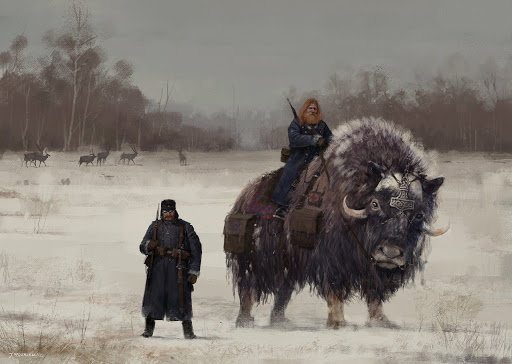Kilkan Yaks
Kilkan Yaks are creatures similar to yaks on Earth but are much larger. They are native to the Ice Kingdom, where they are domesticated for their milk and meat. But they are most popular for their exclusive coat of fur, which is renowned all over the world for the surprising insulation it gives and its shine. They were named in the honor of Kilkan, the person who discovered the species.
Basic Information
Anatomy
Kilkan Yaks are larger than their Earthen counterparts. They can also stand up on two legs and walk. The horns of Kilkan Yaks are small and are located near the snout, instead of on top of the head.
Genetics and Reproduction
Kilkan Yaks have little genetic diversity. They mate just before they go into hibernation, during which time the foetus develops. Hibernation is optional, though, since if the winter is not cool enough, they do not hibernate. In about 6 months, the females give birth to 1-2 calves. The mother takes care of a maximum of 4 calves at once. Once this limit is reached, the mother doesn’t mate till all the calves mature.
Growth Rate & Stages
The Kilkan Yak has two distinct growth stages: the calf and adult stage. It takes about 5-7 years to mature, this process becoming slower if the calves hibernate.
1. Calf Stage This stage lasts for 5-7 years, till the calves mature. In this stage, the calves mainly drink its mother’s milk, and, at about the age of 3-4 years, start eating plant matter. The calves stay with their mothers during this time.
2. Adult Stage After the calves mature and become adults, they leave their mother’s side and live their life themselves.
1. Calf Stage This stage lasts for 5-7 years, till the calves mature. In this stage, the calves mainly drink its mother’s milk, and, at about the age of 3-4 years, start eating plant matter. The calves stay with their mothers during this time.
2. Adult Stage After the calves mature and become adults, they leave their mother’s side and live their life themselves.
Ecology and Habitats
Kilkan Yaks usually live in icy regions and forests in the Ice Kingdom, though they also survive (barely) in hotter regions. But this is avoided since a yak that has been to a hotter region will not have proper offspring.
Dietary Needs and Habits
They are herbivores, and relish eating the leaves of Kilkan Trees, which are very poisonous for humans. However, they also prefer eating Yue flowers, but they never touch the leaves.
Biological Cycle
The Kilkan Yak has two distinct stages: the calf and adult stage. The calf stage lasts for 5-7 years, and the adult stage until its death.
Additional Information
Domestication
These animals are very easy to domesticate. They are usually lured into barns at night using Kilkan leaves. They are held out so that the yaks can get a good smell of them and come towards it.
Uses, Products & Exploitation
The Kilkan Yaks are useful for a lot of things. They're famous for their luscious fur. They are also bred for their sweet milk and also hunted sometimes for their horns. Their horns are used as a symbol of bravery or as amulets worn by the Garhans to keep bad things away. Their fur is also very useful to create different cloth items such as jackets, pockets, and cloth bags. But since it is so precious, only rich people can afford items that come from its fur. The yak meat, also known locally as Uhwad, is known for its juicy and meaty flavour, so it is preferred by people on festivals and other similar occasions.
Facial characteristics
Kilkan Yaks have the facial characteristics of a yak: big mouth, big eyes, and horns. They appear really stupid, but beware, if you make one angry, that might be the last thing you do. They have an emblem on their forehead.
Geographic Origin and Distribution
Across the Ice Kingdom
Average Intelligence
Low
Perception and Sensory Capabilities
A recent study on the yaks showed that they are able to see colours that we can’t even imagine in our brains. It also said that they have a relatively complex ability to smell food from miles away even in the extreme colds. When it isn’t able to see, it uses its amazing sense of smell to know where it’s travelling. This is used to the humans’ advantage so that they could bring wild yaks to a home or barn.
Scientific Name
Yakus Kilkanus
Origin/Ancestry
Kilkan Yaks have characteristics of the extinct herbivores Jilolpas and Hojkals, which were spread throughout Acciphere.
Lifespan
24-26 years
Conservation Status
Kilkan Yaks are widely domesticated, and hence aren’t going to die out anytime soon.
Average Height
2.5 - 4 metres, when fully grown
Average Weight
500-800 kilograms (1100 - 1750 pounds)
Average Length
2-4 metres, when fully grown
Body Tint, Colouring and Marking
The yaks are usually a raw-umber colour with stokes of white caused by the icy temperatures. Their forehead is covered with snow-white fur and has a tight nordic emblem attached to it. The rest of the body is also covered in thick fur. The shape of the horns can also determine from which region of the Ice Kingdom it comes from.
Related Materials
Remove these ads. Join the Worldbuilders Guild









Comments